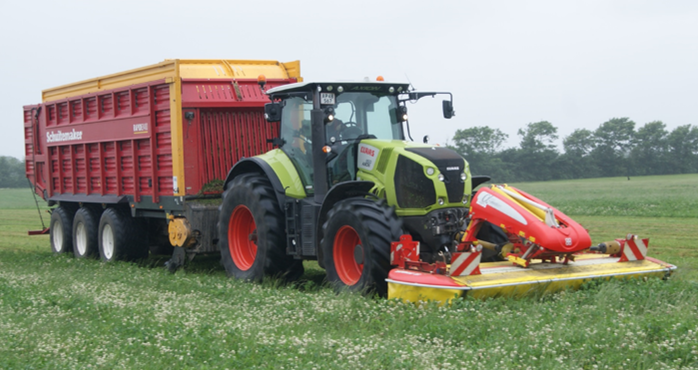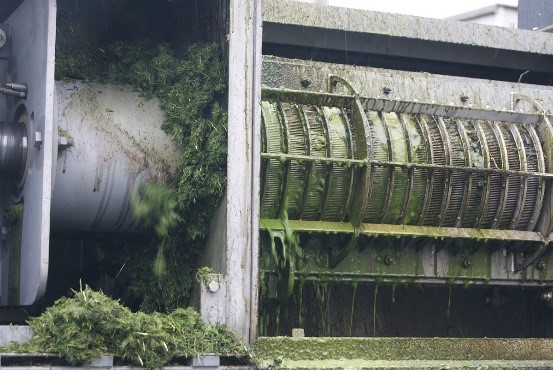Green protein from locally grown crops
Problem
Organic poultry producers are often confronted with high feed costs and a lack of alternative high-quality protein sources for poultry.
Solution
Green protein concentrate can be produced from locally grown crops such as clover-grass (see figure 1) or alfalfa. It can be used in the diets of organic broilers and layers. In a bio-refinery, protein concentrate is obtained by pressing fresh green material (see figure 2), heating/fermenting the juice to precipitate protein and finally putting it in a centrifuge. The concentrated green protein can be dried and added to poultry feed.
Benefits
Concentrate from clover/clover grass and alfalfa has a high protein content and an optimal amino acid profile for poultry, which makes the feed formulation of organic diets more optimal. An increase in locally grown protein sources can improve the sustainability of the farm and make the farmer less dependent upon imported protein, such as soya, from overseas.
Applicability box
Geographical coverage
In temperate climates. Middle and Northern Eu-rope.
Application time
The product can be used at any time of the year if the protein paste are dried and stored under opti-mal conditions.
Required time
Harvest time of green protein during spring, sum-mer and autumn, processing time in a bio-refinery and time to dry it.
Period of impact
Immediate Impact
Equipment
Machinery required for harvest of green material (clover/grass/ alfalfa) and for transportation to a bio-refinery plant or to storage facilities.
Best in
Choice of crop for production of green protein de-pends on the country, soil type and weather condi-tions during preferred harvest time. Advantageous in crop rotation.
Practical Recommendations
- Choose an appropriate type of green crop, such as clover-grass or alfalfa, with an expected high protein and amino acid content. Consider soil types and weather patterns to grow a crop with a good and high quality yield.
- Harvest the field at regular intervals in order to achieve good plant growth and to obtain batches with more high quality protein and less fibre.
- Harvesting procedures, which minimise soil content in the green material obtained from the field are necessary to obtain good quality green protein and to avoid wear of machinery and technical equipment.
- Cooperation with a bio-refinery plant is a prerequisite in order to concentrate the protein into a green paste that can be dried and used in poultry feed.
- If not dried, the wet green paste can be stored in closed containers/plastic bags in cool conditions for a shorter period.
- Chemical analysis of the green protein concentrate is important in order to replace other protein sources such as soya and to carry out the correct feed formulation. This can be done together with advisors or feed companies.
Further information
Video- Video "GRASS PROTEIN - a golden chance to improve organic farming" from Seges
- Report on “Green Biomass – Protein Production Through Bio-refining”
- OrganoFinery: Organic growth with biorefined organic protein feed, fertilizer and energy
- Check the Organic Farm Knowledge platform for more practical recommendations.
About this practice abstract and OK-Net EcoFeed
Publishers:Dept. of Animal Science (ANIS) and Dept. of Engineering (AU) Aarhus University (AU),
DK8830Tjele,
Phone +45 8715 6000/+45 8715 8074,
,
anis.au.dk, eng.au.dkSection for Sustainable Biotechnology, Dept. of Chemistry and Bioscience Aalborg University (AAU),
DK2450Copenhagen,
Phone +45 2447 0418,
,
bio.aau.dkResearch Institute of Organic Agriculture (FiBL),
CH5070Frick,
Phone +41 62 865 72 72,
info.suisse@fibl.org,
www.fibl.orgIFOAM Organics Europe,
BE1000Brussels,
Phone +32 2 280 12 23,
www.organicseurope.bio,
www.organicseurope.bio
Contact: sanna.steenfeldt@anis.au.dk, maj@eng.au.dk, mel@bio.aau.dk
Permalink: https://organic-farmknowledge.org/tool/37034
https://orgprints.org/view/projects/OKNetEcoFeed.html
This practice abstract was elaborated in the Organic Knowledge Network on Monogastric Animal Feed project. The project is running from January 2018 to December 2020. The overall aim of OKNet EcoFeed is to help farmers, breeders and the organic feed processing industry in achieving the goal of 100% use of organic and regional feed for monogastrics.
Project website: https://ok-net-ecofeed.eu/
IFOAM Organics Europe (project coordinator), BE; Aarhus University (ICROFS), DK; Organic Research Centre (ORC), UK; Institut Technique de l'Agriculture Biologique (ITAB), FR; Research Institute of Organic Agriculture (FiBL), CH; Bioland, DE; Associazione Italiana perl'Agricoltura Biologica (AIAB), IT; Donau Soja DS, AT; Swedish University of Agricultural Sciences, SE; ECOVALIA, ES; Soil Association, UK.




This project has received funding from the European Union’s Horizon 2020 research and innovation programme under grant agreement No 773911. This communication only reflects the author’s view. The Research Executive Agency is not responsible for any use that may be made of the information provided. The authors and editors do not assume responsibility or liability for any possible factual inaccuracies or damage resulting from the application of the recommendations in this practice abstract

